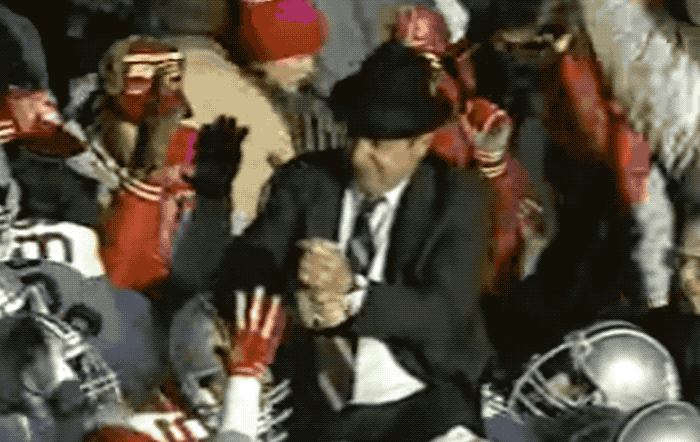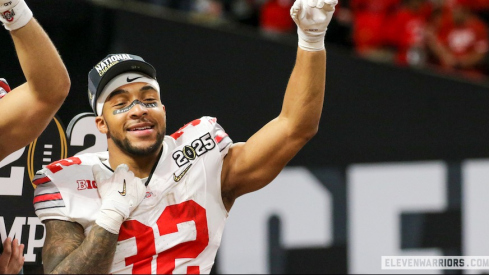Welcome back to My Favorite Things.
We're isolated from each other, trying to survive a global pandemic. Each day brings more uncertainty and terrifying news, as we take shelter from an invisible global scourge. A single cough can send your mind to a dark place. Life is paused. Sports are on hold. This sucks.
My Favorite Things is an escape from all of that. The philosophy is simple:
When I'm feeling sad
I simply remember my favorite things
And then I don't feel so bad
So let's do that. Today we head to Ann Arbor on November 21, 1987. There's one second left in the Ohio State-Michigan football game.
EPISODE TWO: EARLE'S FINAL RIDE
All the Buckeyes had to do was keep the Wolverines from gaining 98 yards on one play.
Michigan's offense was pinned to its own goal line with a second left and a three-point deficit. Not enough snaps left for a game-tying kick. Not enough mystic to travel back in time to the 2nd quarter and go for touchdowns instead of settling for chip shot field goals.
And as it turned out, not enough dark magic to steal the win from a fired coach. Demetrius Brown chucked the final pass of the game skyward as time expired. It bounced off the astroturf 60 yards downfield, and that was it. The visitors had won. Ohio State's bench erupted.
The cruelest week of Earle Bruce's career had come to an end. He had traded the 1987 football season - an abject failure ripe for second-guessing - for a Buckeye football legacy he would not have experienced otherwise. But nobody knew that as the clock hit zero.
All anyone knew was that Michigan had just lost, and Ohio State had won.

When the university fired Earle that Monday it was correctly recognized Ohio State - at the highest level of administration - had forfeited its football season in haste. No one fires their damn coach the week of the biggest game, no matter how poorly things are going.
Firing anyone with one game left looks petty and personal. In Earle's case, the chain of command was broken - his boss Rick Bay didn't fire him; Bay's boss Ed Jennings did, and Bay - a Michigan graduate who had tried to extend Bruce's contract prior to his final season - resigned in protest out of principle.
Earle had started his tenure by going 11-1 with Woody's players and just missed a national championship. Then he went 9-3 six seasons in a row, 10-3 the previous year and now 5-4-1 in his only bad season while heading into his last game. When that final heave bounced off the turf, Earle got his sixth win of the season and earned his ninth set Gold Pants.
His players celebrated. A couple of seconds passed. Then, his feet left the ground.
ONE WEEK EARLIER
Earle had turned down the Arizona job prior to what would be his final season in Columbus.
As long as Woody breathed, Earle had tenure at his alma mater. His three-year deal, at the time, was the longest in school history. The biggest issue the administration had with its football coach was that he was football coach, meaning - that was all Earle was. He didn't really like to do all the other stuff. The public appearances. The community outreach. The booster ass-kissing.
A common Halloween costume in Columbus during the 1980s was to stuff a bed pillow into the front of your shirt, then put on a red Ohio State jacket and button it up. Don a red hat and ta-da - you're Earle Bruce - the corpulent sideline fixture and strategic mind behind the Run Run Pass Punt offense that won 75% of the time, every time.
You were a football coach. That's all Earle ever wanted to be.
Buckeye football players graduated and their teams rarely lost while Earle was running things. Ohio State was the winningest team in the Big Ten during his tenure - even including that lousy 1987 season - and it took down Michigan more often than it didn't, reversing the three-year slide his mentor had suffered on his way into retirement.
Woody died that March, and immediately - whether he realized it or not - Ohio State being forced to tolerate him going 9-3 forever while being just a football coach was no longer in his unwritten contract.
Had he left for Arizona, Earle would have broken the Graveyard of Coaches destiny that defines the job in Columbus. He chose to stay at his favorite place and become yet another Hall of Fame figurehead whose contract would be prematurely terminated. That was his new destiny.
Here's how 1987 went for Earle: On New Year's Day he showed up at the Cotton Bowl with a completely different image from that Halloween costume, wearing a suit and a fedora (with a red feather in it!) instead of his customary cap coaching jacket. Later that month, he quietly accepted and then turned down the Arizona job.
Coaches who leave Ohio State are forgotten. Coaches who reach their natural end in Columbus are immortalized.
His mentor and vocational protection passed away two months later. His best receiver - Cris Carter - secretly signed with an agent, but that was discovered and the Buckeyes' best weapon was now ineligible. The team was ranked No.9 when the Indiana Hoosiers rolled into Ohio Stadium and won by three touchdowns and gave the program its Darkest Day.
Three straight agonizing losses - one at home to Michigan State, one in Madison and the final one on Senior Day to Iowa - ended his career. The university president pulled the trigger. Earle had been recruited to Columbus in 1949, convinced to stay in 1951 when he was no longer able to play - and forced to leave in 1987.
Had he turned over a new leaf in Tucson that January, he becomes just another Ohio State coach. We only talk about Francis Schmidt because of his Gold Pants speech; that guy left Columbus for Idaho. Wes Fesler won the conference, the Rose Bowl, gave us Vic Janowicz - and fled for Minnesota when he realized how important beating Michigan was.
Coaches who leave Ohio State are forgotten. Coaches who reach their natural end in Columbus are immortalized.
If Earle goes to Tucson, Urban Meyer probably never comes back to Columbus no matter who he grew up rooting for in Ashtabula. In January 1987, John Cooper hadn't beaten Michigan in the Rose Bowl yet, so he's not on Ohio State's radar - the Buckeyes probably end up with Don Nehlen. Choosing home over a reset in the desert began a cascade of events decades into the future that began with Earle being fired from his dream job on the Monday of Michigan Week.
Marv Cook scored the winning touchdown that sealed his fate. The Hawkeyes danced in Ohio Stadium on Senior Day while the entirety of the Horseshoe just watched silently as the Buckeyes locked up their worst season in 21 years.
Three straight losses. Then they fired Earle. And the team still had to play Michigan. Up there.

Eight days before Earle passed away from Alzheimer's Disease, former players were congregating outside the Woody Hayes Athletic Center for what has become the annual April presentation of the Gold Pants.
I was chatting with Jim Lachey and Mike Tomczak when Dr. John Frank - the last tight end Ohio State football truly weaponized - strolled in from the parking lot.
"Hey doc, you're late," someone sneered at Frank.
"I was visiting with Earle," he smiled.
It was more of a tempered, medical smile than a joyful one. Frank quietly chatted with his old teammates and friends about their coach being moved from where he was being cared for to a more appropriate place for his deteriorating condition.
Frank's smile briefly shifted from medical to melancholy, as it seemed Earle found his old star tight end to be friendly and familiar during his visit. I like this visitor. I know him. That's one of the rare victories with this disease; actually being remembered. One of my earliest childhood memories is seeing my grandfather chastising my mother from the couch he rarely left, for allowing "this old woman" to take care of him.
That old woman was my grandmother, his wife of several decades. Being remembered, even if it's by tone or facial expression and not by direct identification, is a win. Dr. Frank knew what a win looked like with Alzheimer's, and his face briefly reflected it. Frank was taken in the 2nd round of the NFL Draft after deciding to skip the combine in favor of studying for his final exams. Earle's best tight end is as authentic as he is smart.
His old coach was in his final days, and he had stopped in to briefly see him on his way to the practice facility named for his coach's mentor, where he would participate in a ceremony led by his coach's most famous mentee. A ceremony reserved for teams that had beaten Michigan, an achievement Earle understood as well as any coach Ohio State has ever had.
Earle participated in nine wins over the Wolverines; one as a medically-retired player/coach, three as a Hayes assistant and five as the head coach. He was on freshman team when the Buckeyes lost the Snow Bowl and went 1-3 in that game as a student. He was on the staff in 1966, 1969 and 1971 when Michigan got the better of them. He lived and died with the outcome of that game long after he stopped roaming Ohio State's sideline.
When the Buckeyes beat the Wolverines in Ann Arbor in 1981 - his second-straight win up there - the team carried him off the field. When time expired in 1987, they carried him out of Michigan Stadium again.
It wouldn't be the last time. The university had fired Earle, but Ohio State lifted him back up. The community lifted him up. His players like Dr. Frank; his pupils like Urban Meyer - they all lifted him up.
That all began as the final second peeled off the scoreboard in Ann Arbor in 1987. Ohio State then picked up its fired coach and never put him down.

Every emotion washed through Earle as he left the field for the final time.
His tenure had ended. Ohio State's three-game slide was over. Ohio State's season was over. Michigan's only winning streak against him - two games - was over. That terrible week was over.
Earle's legacy as we would forever know it crystalized in Ann Arbor that afternoon, when his players rallied around him and won the only game that ever mattered. The man who was just a football coach whose only public emotion was stoicism - was now openly weeping on national television. The fall and rise of Earle Bruce took exactly one week.
And then he rode off into the sunset on the shoulders of his own giants.



